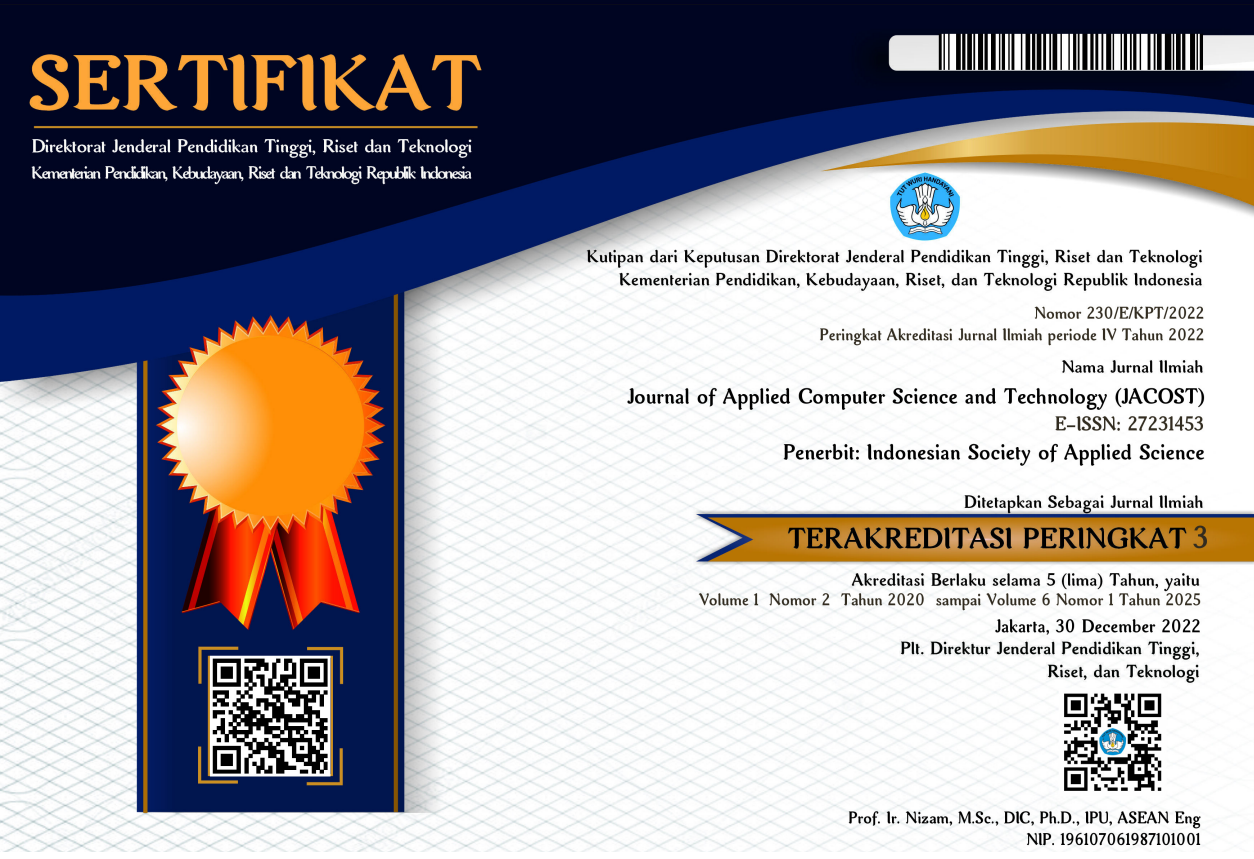Penerapan Face Recognition Pada Sistem Presensi
I will put the dimension here
Abstract
The development of digital image technology is increasing nowadays. However, the use of image technology on surveillance cameras has not been optimally utilized. On the other hand, the various presence data monitoring systems that currently exist have their respective advantages and disadvantages, and need to be continuously developed so as to facilitate the data processing. The student attendance system at STT Bandung is basically good but it is still not optimal. The process of collecting student attendance data is still quite time-consuming and still allows human errors to occur in the data input process. Therefore, the author intends to help overcome this by utilizing face recognition technology in an integrated presence process. LBPH (Local Binary Pattern Histogram) is currently the best method in face recognition technology because the detection and recognition process is relatively fast and has the highest level of accuracy when compared to other methods. After testing the resilience of the system from the results of the prototyping that was built, the results obtained with a success rate of 86.85%.
Downloads
References
Firdaus, M.I., Ridho, I.I., 2016. Aplikasi Pendeteksi Wajah Menggunakan Metode Haar. Media Sains, 9 (1). pp.27-31.
Suheri, C., Ruslianto, I., 2017. Identifikasi Wajah Manusia untuk Sistem Monitoring Kehadiran Perkuliahan menggunakan Ekstraksi Fitur Principal Component Analysis (PCA). Jurnal Edukasi dan Penelitian Informatika (JEPIN), 3 (1). pp.9-15.
Luisan W.A., Steven R.S., Alwin M.S., 2017. Implementasi Algoritma Pengenalan Wajah Untuk Mendeteksi Visual Hacking. E-Journal Teknik Informatika. 11 (1).
Chi Ho Chan, 2008. Multi-scale Local Binary Pattern Histogram for Face Recognition, School of Electronics and Physical Sciences, University of Surrey, Guildford, Surrey.
Chakka M., Venugopal P., 2016. Face Detection and Recognition Using LBPH. International Journal of Engineering Sciences & Research Technology (IJERST), 5 (3). pp.10-16.
OpenCV, 2020. About. [Online] (Updated 15 Jun 2020). Tersedia di : http://opencv.org/about.html. [Accessed 18 Sep 2020].
Shehu, V., Dika, Agni., 2010. Using Real Time Computer Vision Algorithms in Automatic Attendance Management Systems. 32nd International Conference on Information Technology Interfaces (ITI). Cavtat, Croatia, 21-24 Jun 2010. IEEE : Croatia.
Wagh, P., Thakare, R., Chaudhari, J., Patil, S., 2015. Attendance System Based On Face Recognition Using Eigen Face And PCA Algorithms. International Conference on Green Computing and Internet of Things (ICGCIoT). 1. pp.303-308.
Fuzail, M., Muhammad, H., Nouman, F., 2014. Face Detection System for Attendance of Class Students. International Journal of Multidisciplinary Science and Engineering, 5 (4). pp. 6-10.
Shafiqul, M., Mahmud, A., Papeya, A.A., Onny, I.S., 2017. Real Time Classroom Attendance Management System. Department of Computer Science and Engineering. BRAC University.
Kortli, Yassin., Jridi, Maher., Al Falou, Ayman., Atri, Mohamed., 2018. A Comparative Study of CFs, LBP, HOG, SIFT, SURF, and BRIEF Techniques for Face Recognition. Proc. SPIE 10649, Pattern Recognition and Tracking XXIX. 10649.
M.P. Inen., M. Pietikäinen., A. Hadid., G. Zhao., T. Ahonen., 2011. Computer Vision Using Local Binary Patterns. Springer.
M. S. Karis., N. R. A. Razif., N. M. Ali., M. A. Rosli., M. S. M. Aras., M. M. Ghazaly., 2016. Local Binary Pattern (LBP) with application to variant object detection: A survey and method. IEEE 12th Int. Colloq. Signal Process. its Appl. CSPA 2016, March. pp. 221–226.
F. Deeba., A. Ahmed., H. Memon., F. A. Dharejo., A. Ghaffar., 2019. LBPH-based enhanced real-time face recognition. Int. J. Adv. Comput. Sci. Appl., 10 (5). pp.274–280.
Hanuebi, A., Sompie, S., Kambey, F., 2019. Aplikasi Pengenalan Wajah Untuk Membuka Pintu Berbasis Raspberry Pi. Jurnal Teknik Informatika., 14 (2). pp.243-252.
R Vemulapalli, A Agarwala., 2018. A Compact Embedding for Facial Expression Similarity. CoRR, abs/1811
Copyright (c) 2021 Andri Nugraha Ramdhon, Fadly Febriya

This work is licensed under a Creative Commons Attribution-ShareAlike 4.0 International License.
Pernyataan Hak Cipta dan Lisensi
Dengan mengirimkan manuskrip ke Journal of Applied Computer Science and Technology (JACOST), penulis setuju dengan kebijakan ini. Tidak diperlukan persetujuan dokumen khusus.
- Hak cipta pada setiap artikel adalah milik penulis.
- Penulis mempertahankan semua hak mereka atas karya yang diterbitkan, tak terbatas pada hak-hak yang diatur dalam laman ini.
- Penulis mengakui bahwa Journal of Applied Computer Science and Technology (JACOST) sebagai yang pertama kali mempublikasikan dengan lisensi Creative Commons Atribusi 4.0 Internasional (CC BY-SA).
- Penulis dapat memasukan tulisan secara terpisah, mengatur distribusi non-ekskulif dari naskah yang telah terbit di jurnal ini kedalam versi yang lain (misal: dikirim ke respository institusi penulis, publikasi kedalam buku, dll), dengan mengakui bahwa naskah telah terbit pertama kali pada Journal of Applied Computer Science and Technology (JACOST);
- Penulis menjamin bahwa artikel asli, ditulis oleh penulis yang disebutkan, belum pernah dipublikasikan sebelumnya, tidak mengandung pernyataan yang melanggar hukum, tidak melanggar hak orang lain, tunduk pada hak cipta yang secara eksklusif dipegang oleh penulis.
- Jika artikel dipersiapkan bersama oleh lebih dari satu penulis, setiap penulis yang mengirimkan naskah menjamin bahwa dia telah diberi wewenang oleh semua penulis bersama untuk menyetujui hak cipta dan pemberitahuan lisensi (perjanjian) atas nama mereka, dan setuju untuk memberi tahu rekan penulis persyaratan kebijakan ini. Journal of Applied Computer Science and Technology (JACOST) tidak akan dimintai pertanggungjawaban atas apa pun yang mungkin timbul karena perselisihan internal penulis.
Lisensi :
Journal of Applied Computer Science and Technology (JACOST) diterbitkan berdasarkan ketentuan Lisensi Creative Commons Atribusi 4.0 Internasional (CC BY-SA). Lisensi ini mengizinkan setiap orang untuk :.
- Berbagi — menyalin dan menyebarluaskan kembali materi ini dalam bentuk atau format apapun;
- Adaptasi — menggubah, mengubah, dan membuat turunan dari materi ini untuk kepentingan apapun.
Lisensi :
-
Atribusi — Anda harus mencantumkan nama yang sesuai, mencantumkan tautan terhadap lisensi, dan menyatakan bahwa telah ada perubahan yang dilakukan. Anda dapat melakukan hal ini dengan cara yang sesuai, namun tidak mengisyaratkan bahwa pemberi lisensi mendukung Anda atau penggunaan Anda.
-
BerbagiSerupa — Apabila Anda menggubah, mengubah, atau membuat turunan dari materi ini, Anda harus menyebarluaskan kontribusi Anda di bawah lisensi yang sama dengan materi asli.





















